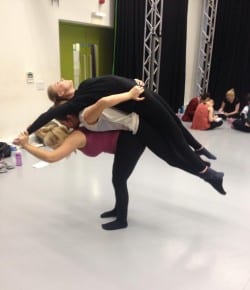Allowing the weight of the head and focus of the eyes to assist easy changes of direction and level.
Danielle Lepkoff’s Movement of Intention, came into play prior to the workshop. Reading this interview, I found her answers helped answer several of my own questions about contact improvisation, Her reply; ‘I feel many of the younger dancers who are exploring improvisation or spontaneous composition are unaware of a wealth of inspired research and developed knowledge that I think might be very apropos to their questions’, influenced me to research more into contact improvisation in order to become more knowledgeable about the history and development of improvisation. The videos which we watched in this weeks workshop are an example of research in the development of improvisation. Steve Paxton’s “Interior Techniques”: Contact Improvisation and Political Power, expresses the view of improvisation being a form of power. He sees the potential impact of contact improvisation to return the decision-making authority to the dancer, by developing the habit of attention. He gives importance to having an awareness of the body’s reflexes as a way of communication between the reflexes of people. The reading allowed me to think about how I should react to peoples reflexes in order for the improvisation to run smoothly.
The workshop started by viewing two movement pieces online:
Steve Paxton’s Magnesium (1972)
Nellis and Brando Earth Dance (2010)
The two dance pieces were significantly different as they were both created forty years apart, see video’s above. Within them you can see the similarities as well as the differences. The videos allow us to see the significant difference between early contact improvisation and the development of improvisation within the 21st century. The main difference I found was the obvious fluidity difference between the two. Earth dance appeared to be much more fluid, controlled and involved safe practice. Whereas Magnesium appeared to be more stop and start, unsafe and non-flowing. I almost felt as though during Earth dance there was a friendly loving relationship between the two. However, during Earth dance I felt an atmosphere of war and the eagerness to get away from their partners. However, both videos gave me an insight to what can be created through contact improvisation. Magnesium shows a clear progression and development of contact improvisation throughout the years. It shows use the use of safe practice, knowledge and strength in order to create a successful improvisation.
We then went on to move around the space, slowly reaching the floor. Next we were given a task to keep our head connected to the floor whilst moving, rolling and sliding along the floor. We then went on to partner work where we both had to keep our heads attached at all times. I felt this soothing as I gave full trust to my partner, following their movement and her following mine. The challenge often became difficult if one of us moved drastically however, we eventually came back into contact. For the majority of the workshop we practiced rolling along one another’s backs with our backs, finding the appropriate position in order for the movement to run smoothly. At first I found this difficult as my partner was significantly taller to what I am, therefore getting the right body on body connection was key in order to perform safe practice. I also found it rather difficult to relax my head and neck at first as I was conscious of where I was going to land, but after a few practices I felt more comfortable and able to relax my head. During my partner rolling on my back I felt as though I was a sturdy base creating a table with my back on all fours. I took the weight into my hands which allowed me to maintain the position for a long time. Each task during this week’s workshop has allowed me to gain trust in myself as well as others, transferring my weight onto them, and vice versa.
During the jam this week, I put the principles of rolling into practice. Unlike last week, I felt fully comfortable rolling across my partners. I found a connection between my body and head relaxing the muscled in my neck in order for the rolls to look effortless. I found working with the lights off helped me to relax and engage with my environment. At one point in the jam, I found myself and my partner becoming entranced in the movement, giving our full weight to each other during rolls,connect and flow together effectively. I left the jam feeling fully relaxed and at ease with the rolling aspect of contact improvisation. I started to ask myself questions;
How can we bring this movement off the ground?
How can we travel the rolling movements more, creating more diversity?
